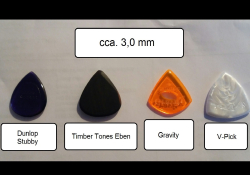
Can You Choose the Right Guitar Pick?
Beginning guitarists face a number of decisions. The only reassuring thing is that most of them are not final, and you can change them sooner or later. Every change indeed takes some effort, but that is the only downside to experimenting with picks – just about the most used piece of your gear, and one that has a significant effect on your tone and technique.
During my first five years of playing, I got from a pick cut out of a margarine lid (0.88 mm pick being too thick for me) to a 3.0 mm one. After another fifteen years, however, I started experimenting with picks again. Moreover – while most guitarists have their one pick, others keep changing them for different instruments or parts, as needed.
But first, how to decide at the very beginning. Generally, there are a few criteria. The main one is your feeling of playing it, however subjective it may be. The pick should not get in your way. I’m not saying it’s supposed to be comfortable because that way, you’ll end up with one made out of that lid. Such a pick could be OK for accompaniments, but for playing other stuff, it is somewhat inaccurate, as it is too flexible. On the other side is the coin, used, for example, by the guitarist of Queen or, in a modified version, by Guthrie Govan. There is no specific rule, but thickness is a clear parameter that can be experimented with well.
The size and shape of the tip
While size is all about ergonomics, tip shape greatly relates to playing technique. Ergonomics is essential, and it depends on how you handle the pick. Especially if (like me) you alternate between the fingerstyle and pick methods, you need some finesse on where to hide the pick. For me, it’s easy to hide a small pick between my fingers or in the palm of my hand, but others find smaller picks fall out of their hands. The shape can go from a pointed tip to a round one. Also, there are picks with three playing options, each corner having a different shape. For faster and more articulate playing, a pointed tip is better, but again, for accompaniments (like for an acoustic guitar), a round tip is preferred. Articulation and sharpness of tone also vary according to the shape of the tip.
Materials and grip
The material affects the sound and the grip (supported by the little notches or holes that are supposed to prevent the pick from falling out of your hand and sliding unwantedly between your fingers). The grip is, simply put, the hold of the pick in your hand. It’s very subjective, and things like how sweaty your hands get when you play influence it.
The most common material is plastic, but beware, there are also significant differences here. For example, my most used pick now is as smooth as the one I used to have, but it doesn’t fall out of my hand (it even kind of sticks to me :-).
It quite surprised me how effective the little holes in the picks are. For me, they work best against the pick falling out of hand. Metal picks are relentless, they wouldn’t bend a bit and usually produce a very aggressive tone. It’s a bit hard attack on the strings, plus they are not the cheapest ones. Wooden ones are an interesting category, I find them sound good with semihollow guitars and nylon strings. Here it’s very much about your ear and taste.
Price and colour
Strange combination, isn’t it? Once I ordered a pick for a few bucks and found it perfect in every way. Except it was transparent. So it’s probably hidden somewhere in my flat, and I’ll never find it again. There’re a lot of jokes among musicians (and their partners) about losing picks. And it can get a little more serious when you can’t see your perfect pick while at a gig. I like black colour, so I have a lovely black-coated speaker box – on which I can never see a black pick. But then again, there’s a white carpet at my place.
These lines are far from exhaustive. It’s just my experience. So experiment, and keep your mind, heart and ears open. Have a pleasant guitar journey.
In the picture below, you can see the picks I am trying out now.
If you have found an error or typo in the article, please let us know by e-mail info@insounder.org.


